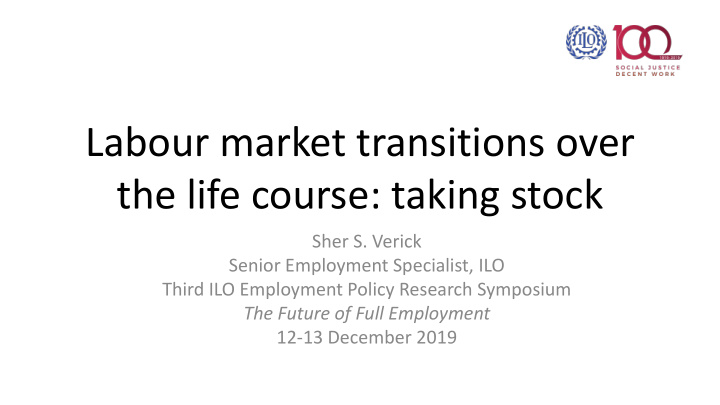



Labour market transitions over the life course: taking stock Sher S. Verick Senior Employment Specialist, ILO Third ILO Employment Policy Research Symposium The Future of Full Employment 12-13 December 2019
Context Transitions between different labour market statuses have critical implications for full employment • Flows into and out of un(der)employment during and following a recession • Job-to-job flows as a key part of structural transformation • Transition to formality Global concern that the labour market is being buffeted by technology, globalization, demographics (we are living/working longer…), etc. • Are we experiencing an increased instability in jobs and greater transitions to more diverse forms of work ? What is driving transitions?
Context ILO Declaration for the Future of Work 2019 “… integration of young people into the world of work” and “…help older workers to expand their choices” Calls for “ effective lifelong learning and quality education for all” and “ effective measures to support people through the transitions they will face throughout their working lives ”
Outline • Traditional approach to labour market transitions • Extending concepts, analytics and policies to address other transitions over the life course
Traditional approach to LMT Labour market transitions = movements of individuals between the labour market statuses of employment, unemployment and inactivity • Theory – Search and matching models of Diamond-Mortensen-Pissarides • Empirics – Micro data – panel or retrospective data – Transitions probabilities and modelling of determinants (education, gender, labour market institutions …) • Policy response – ALMPs and social protection (unemployment benefits) – activation in EU context and important role of PES – extensive focus on youth – Large literature on impact of these policies and programmes
Job-to-job transitions Hyatt (2015) – different factors have been attributed to the decline of J-t-J transitions in US, including aging workforce, rising educational attainment, and declining entrepreneurship Source: Hyatt, H., Spletzer, J. "The recent decline in employment dynamics" IZA Journal of Labor Economics 2:5 (2013): 1 – 21
School-to-work transitions ILO definition of a good transition - passage of a young person (aged 15 – 29) from the end of schooling (or entry to first economic activity) to the first stable or satisfactory job. Source: Elder (2014)
Transitions in segmented labour markets (developing countries) Transitions between informal and formal employment have been studied in a growing number countries E.g. Lack of mobility/persistence in South Africa (Verick, 2012) – importance of education Source: Verick (2012) Journal of African Economies
How do we expand our scope to transitions over the life course ? Conceptual – How do Analytical – How Policies – What are we define a “good” should we measure the implications for transition? transitions (quality and policy responses? quantity)? Where does choice fit in? What factors drive transitions? Relevance to developing countries?
DG’s message at the G20: From a three - stage life to a multistage life Three-stage model Education Work Retirement age0 age60 age20 Multistage life Self-employment Retirement Education Training Volunteer Employment in an organization Mix of paid work Flexible work and unpaid work
What is does it mean to look at the life course? • LIVES research programme (CH) – “…life -course perspective suggests an action framework for policy-making that recognizes the connections across all stages and domains in life .” – “… it links human development in a holistic way, physically and psychologically linking individuals to the social, cultural and historical context .” – Risks are dynamic - over time risks change, gain in importance and intensity or worsen in combination with other risks • Interaction between economic, social and political factors – E.g. implications of social norms for women entering and exiting the labour force during their life course • Ambitious agenda to bring to labour market transitions…
How do we define a good transition? • Transition towards decent work • Sen’s capabilities approach - implies that the freedom to make labour market transitions is a goal in itself – The freedom of women to seek employment outside the home is a crucial transition in the development process. • Schmid – transitional labour market approach
Data and analytical challenges • Data covering individual’s life course is much harder to get – but we can look at cohorts • How do evaluate sequencing of transitions? – Mutchler et al. (1997) – “ The life course approach suggests that analytical attention must be directed to both events and sequences or patterns” – E.g. Retirement is a process; identify “crisp” versus “blurred” transition patterns of older workers (i.e. re-entry of older people into the labour market) • How do we model determinants of such sequences with multiple dimensions?
Mutchler et al. (1997) - Labour force transition patterns by age One key finding - Lack of nonwage income and pension availability are strongly associated with blurred exits
Rate of Multiple policy dimensions return Demand side matters as well Social skills Types of returns – coherence between policies Cognitive Basic skills skills Occupational skills Norms and values Personal Less social Nurseries Work traits isolation Childcare Children Improved Education Early health Types of policies childhood ALMPs education Preventative Stipends Life-long Pension Social measures Parental learning Vocational protection Rehabilitation leave Home help training Life course Infants + Old age Youth Prime age children Transitions Source: Based on Jon Kvist, A framework for social investment strategies: Integrating generational, life course and gender perspectives in the EU social investment strategy, 2014
Moving forward • Need better understanding of quantity and quality of transitions over the life course – Define a good / decent work transition – sequencing? – Identify determinants – Focus on other groups, in addition to youth: transitions of older workers, women’s entry and exit from LF • Policy response is broader than ALMPs, incl. LLL, social protection but demand-side also matters – an integrated approach is needed – How should institutions, including PES, respond? • More research is required , particularly on developing countries
Recommend
More recommend